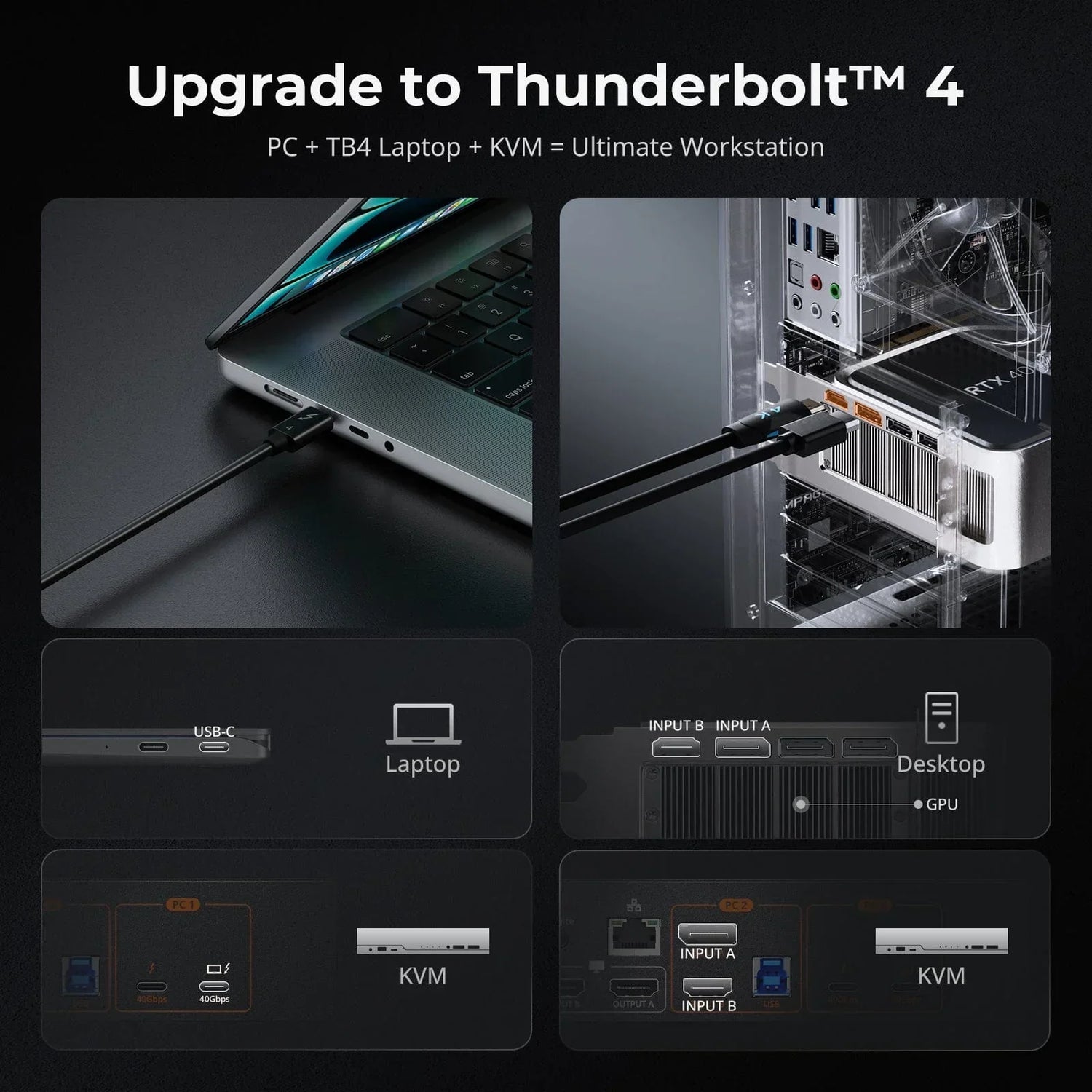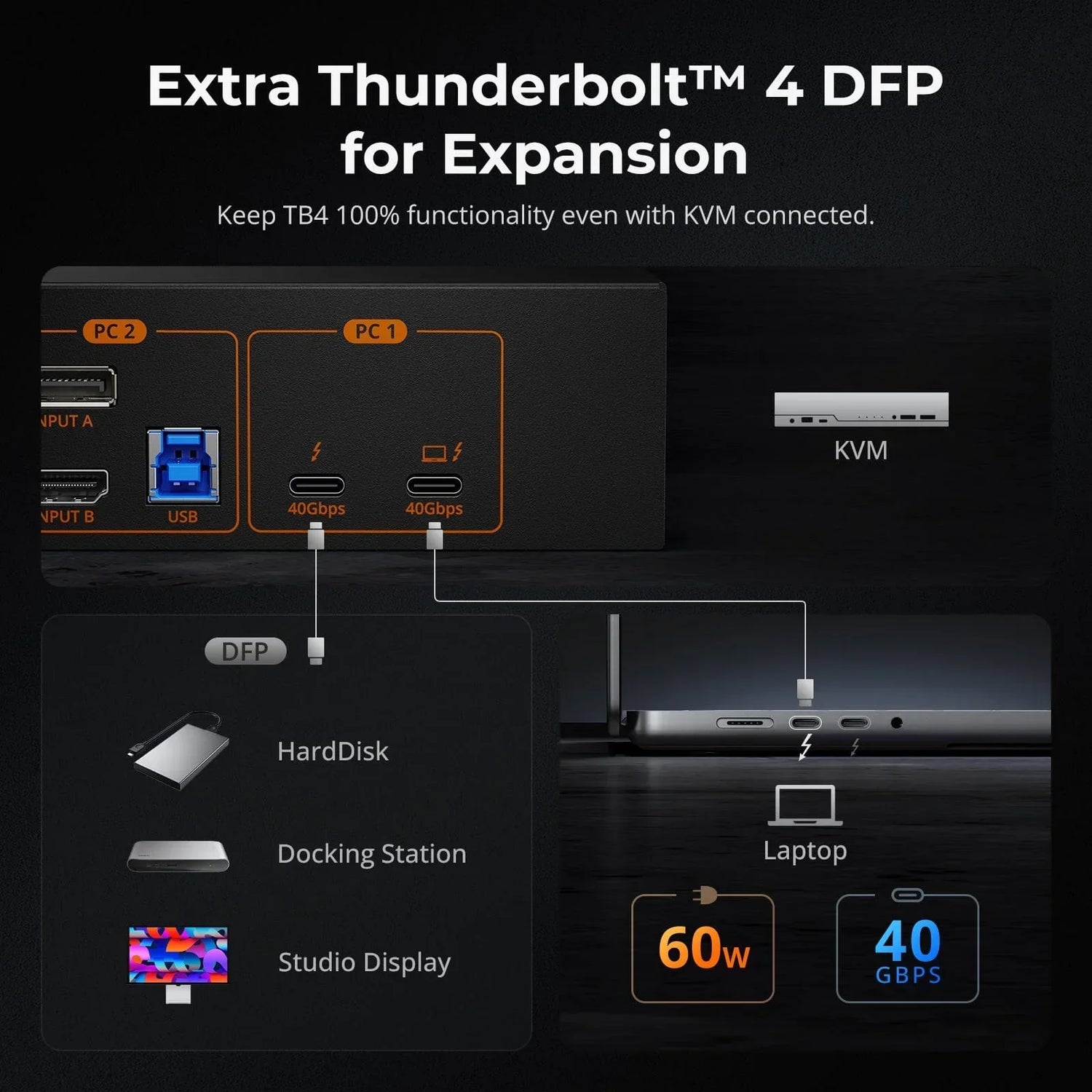What is USB 3.0?
USB 3.0, also known as SuperSpeed USB, is a widely adopted standard for Universal Serial Bus (USB) interfaces. It was introduced in November 2008 and offers significant improvements over its predecessors, including faster data transfer rates, improved power management, and increased bandwidth. Most modern computers and devices support USB 3.0, and it has become the standard for high-speed data transfer and connectivity in many applications.
What is KVM Swtich?
A KVM (keyboard, video, mouse) switch is a hardware device that allows users to control multiple computers using a single set of peripherals, including a keyboard, monitor, and mouse. It acts as a centralized hub, enabling users to switch between connected computers seamlessly.
The KVM switch usually offers ports compatible with the same interfaces as those found on the computer and the monitor it supports, which include but are not limited to HDMI (High-Definition Multimedia Interface), DP (DisplayPort), and USB ports.
As USB is a universal connector that takes the most share in the market, it is easy and convenient for you to use USB KVM switches if you want to control multiple PCs or laptops.
Main Types of USB
USB Type-A This is the standard USB connector that most people are familiar with. It's rectangular in shape and is commonly used for connecting peripherals like keyboards, mice, printers, and external hard drives to computers and laptops.
USB Type-B This is less common and is often found on larger peripherals like printers and scanners. It's square or rectangular with beveled corners and is used to connect these devices to computers.
USB Type-C This is a newer, smaller, and reversible connector that is increasingly popular. It is symmetrical and can be plugged in either way. USB Type-C offers faster data transfer speeds and higher power output compared to older USB types. It's used in many modern smartphones, tablets, laptops, and peripherals.
Micro-USB This connector is smaller than USB Type-A and Type-B and is commonly used for charging and data transfer in smartphones, tablets, and other portable devices. It's not reversible like USB Type-C.

USB Standards
USB standards refer to different versions and specifications that define how USB devices connect and communicate. These standards determine factors like data transfer speed and power delivery, ensuring that devices can work together. From the earliest USB versions to the latest one, like USB 4.0, each update brings improvements to make connecting devices easier and faster.

Why Choose USB 3.0?
Faster Data Transfer Speeds USB 3.0 offers significantly faster data transfer speeds compared to USB 2.0. With a maximum transfer rate of up to 5 Gbps (gigabits per second), USB 3.0 can transfer large files much more quickly, making it ideal for tasks like transferring photos, videos, and large documents.
Widespread Device Support USB 3.0 is one of the most common USB versions currently available, with support for a wide range of devices, including computers, external storage devices, printers, cameras, and more. While USB 3.1 and 3.2 offer faster speeds, their market penetration is not as high as USB 3.0. Likewise, USB 4.0 requires hardware support with higher costs, limiting its current usage mainly to high-end markets and specialized fields.
Improved Power Efficiency USB 3.0 is more power-efficient than its predecessors, which means it can deliver more power to connected devices while consuming less power itself. This is particularly useful for charging smartphones, tablets, and other devices, as well as powering external hard drives and peripherals.
Backward Compatibility USB 3.0 is backward compatible with USB 2.0 and USB 1.x, which means you can still use USB 3.0 devices with older USB ports. However, you won't get the full speed benefits unless both the device and the port are USB 3.0 compatible.
Cost-Effectiveness USB 3.0 is relatively lower in cost compared to USB 3.1, 3.2, and beyond. The implementation of USB 3.1 and 3.2 requires higher technical and equipment costs, making USB 3.0 more suitable for widespread consumer adoption.
Benefits of Using USB 3.0 KVM Switches
Saving Workspace Instead of needing separate keyboards, mice, and monitors for each device, a KVM switch enables you to control multiple computers using a single set of peripherals, freeing up valuable workspace for other tasks or items. Additionally, by centralizing control of multiple computers, a KVM switch eliminates the need for additional desks or work areas, further optimizing the use of available space.
Quick Switching Switching between gaming platforms is as simple as pressing a button on the KVM switch or using keyboard shortcuts. This allows you to switch from playing on your PC to gaming on your console (or vice versa) like PS5, Xbox, or Nintendo Switch without any downtime, providing a smooth transition between gaming sessions.
Productivity Boosting With a KVM switch, you are also able to seamlessly switch between computers without the hassle of disconnecting and reconnecting computers or laptops. This can improve workflow efficiency and productivity, especially in tasks that require using different software or operating systems.
Reduced Cable Clutter Working and gaming setups can quickly become cluttered with cables from multiple devices. By using a KVM switch, you can reduce cable clutter by consolidating all your peripherals into a single setup, creating a cleaner and more organized gaming environment.
Docking Station Functions Some KVM switches offer a unique advantage as they seamlessly double as docking stations, providing users with an extensive array of ports and features. With their multifaceted design, they offer you the convenience of enjoying the features of a KVM switch while benefiting from the versatility of a docking station shared among multiple computers or laptops.
For instance, TESmart KVM switch docking stations facilitate connectivity between various combinations of devices, including 1 laptop and 1 desktop, 2 laptops, 2 laptops and 2 PCs, 1 laptop and 3 PCs, and up to 4 PCs for dual, triple, and quad monitor setups.
Why Buy USB 3.0 KVM Switch Docking Stations from TESmart?
- Serve as a KVM Switch as well as a Docking Station for multiple laptops and PCs
- Various port designs (HDMI, DP, USB, etc.) for demanding needs
- Support USB 3.0 ports (with MST function) with superspeed data transfer rate
- Effortlessly switch inputs using hotkeys, the front panel button, or the remote control
- Support high-resolution and high refresh rate for better gaming experience
- EDID emulation prevents resolution and icon rearrangement
- K&M pass-through for various keyboards, including wired, wireless, mechanical, and gaming keyboards
- Built-in LAN port allows laptops and desktops to access the internet with a network cable
Choosing the Right USB-C KVM and Docking Station
Conclusion
The integrated use of USB 3.0 ports with KVM switches while using KVM switch docking stations can provide users with a more flexible and efficient working environment. If your work demands seamless connectivity across multiple devices or you're an avid gamer looking to streamline your setup, consider the USB 3.0 KVM switch workstation, offering unparalleled versatility, effortless device switching, lightning-fast data transfer speeds, and enhanced productivity. Say goodbye to cable clutter and hello to a more efficient workspace.





